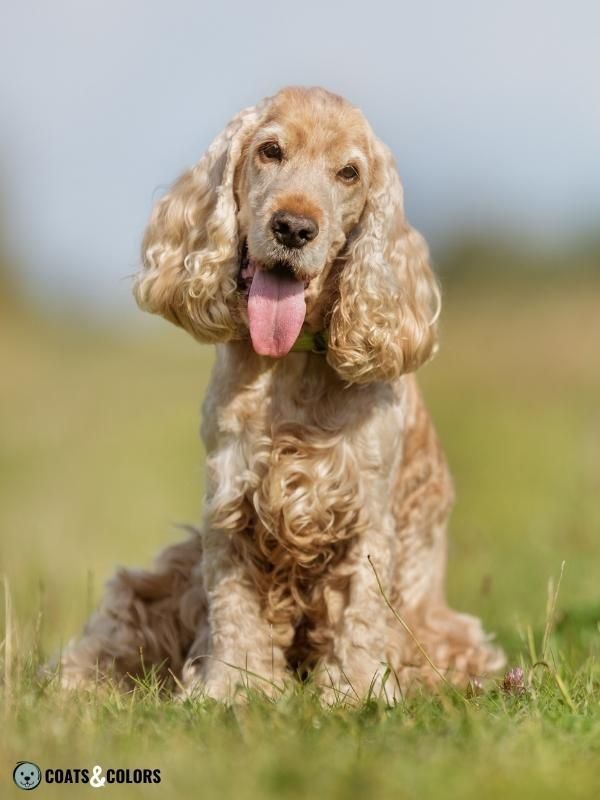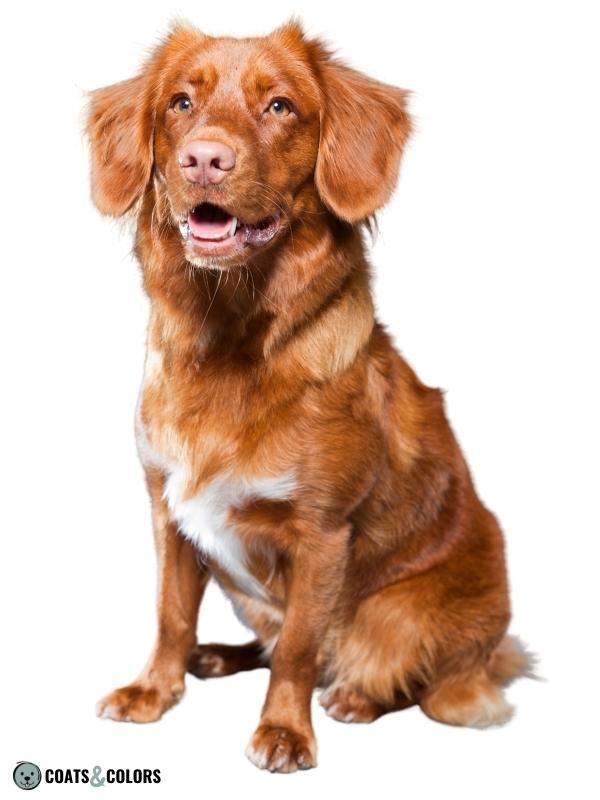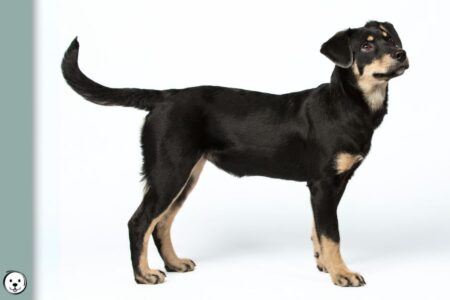Recessive red (e/e) causes a dog to only produce phaeomelanin in all pigmented areas. Many dog breeds with a solid white, yellow, or red coat are in fact e/e-red.
What is Recessive Red?
Usually, pigment cells can produce both types of pigment, eumelanin and phaeomelanin.
But by default, pigment cells produce only phaeomelanin.
They need a signal from outside the cell to switch to eumelanin. And the E locus contains the blueprint for how to build the receptor that is supposed to receive these signals.
And recessive red dogs are homozygous for a loss-of-function mutant allele (e/e). This prevents pigment cells from ever receiving the signal they need to switch to eumelanin production.
What you get is a dog that can only produce phaeomelanin in all pigmented areas.

This gives recessive red the ability to mask any other color or pigment pattern that needs eumelanin to express normally. So the E locus has epistatic control over all the other base patterns.
A recessive red dog could be masked, brindle, dominant black, recessive black, clear sable, shaded sable, agouti, saddle pattern, tan point, or even merle “underneath” its solid coat.
But it’s impossible to see what genotype a recessive red dog actually has at its other loci. That’s because all these other patterns would need eumelanin to be visible in the phenotype.
By the way, the same is true for very clear sable (and some domino phenotypes in sighthounds or northern breeds) which all can easily be confused with recessive red dogs.

In most cases, we can guess what base color a dog’s eumelanin would have had since eumelanin is still responsible for the color of the lips, eye rims, any skin spotting, or nose leather.
Typical signs of a recessive red pattern are pale whiskers and fading nose pigment (snow nose).

Recessive red is sometimes called recessive yellow.
But affected dogs can actually have any color between off-white, ivory, cream up to yellow, orange, or red, depending on what color intensity a particular dog can express.

The e Allele
The MC1R gene at the E locus contains the building plan for the melanocortin 1 receptor. This receptor is found in the membrane of pigment cells where it plays a central role in pigment type switching.
Pigment cells by default produce phaeomelanin. They have to be ordered to produce eumelanin.
The receptor built from the mutated e allele lost the ability to detect signals that trigger eumelanin production. So the pigment cells of an MC1R-deficient dog can only make phaeomelanin.
The e allele is a loss-of-function variant.
It is the most recessive trait at the E-Locus, hence the name recessive red. We currently know of three different mutations (e1, e2, e3) that all cause a loss of function at the E locus and produce the same phenotype. But there may be more that are not testable at the moment.
The e1 variant is most common and found in many different dog breeds while e2 and e3 are rare breed-specific variants[2,4]. The e2 variant was found in cream-coloured Australian Cattle Dogs and e3 was found in white Alaskan Huskies and Siberian Huskies[4].
To express recessive red a dog has to be homozygous recessive e/e. But any combination of e alleles (e1/e1, e1/e2, e1/e3, e2/e2, e2/e3 or e3/e3) will give a recessive red phenotype.
Only dogs that have at least one copy of any other allele at the E locus are able to express both pigment types. These dogs can still be e carriers (Em/e, E/e, eA/e, eG/e, eH/e) and produce recessive red with other e carriers. This can cause some mismarks in breeds that are not supposed to have recessive red.
When testing, you should consider your dog’s breed background since not all companies test for all variants (most test only for e1). This can lead to the report of a false negative result (if they don’t test e2 or e3, they assume the gog has a wild type E).
Since it’s impossible to know what a recessive red dog’s genotype has to offer otherwise (brindle, merle, etc.), genetic testing is in any case highly recommended if you want to breed.
This is especially true if Merle is involved, since recessive red HIDES any merle phenotype.
Hidden merle creates the risk of accidentally pairing two merle dogs and producing double merle because even the flashiest merle isn’t visible in a recessive red parent.
Variations Of Recessive Red
Recessive red causes a mostly uniform coloration in all pigmented areas. An affected dog can’t express any pattern that would require at least some eumelanin.
If a dog has black shading or had black shading as a puppy or if it has at least some black hair tips along the back, on the ears or its tail, it is not recessive red.
But even truly recessive red dogs can still show a variety of different phenotypes.
They can have white, yellow, or red pigment, show white spotting with or without ticking or roan and can have different nose and eye colors.
Color Intensity
Phaeomelanin intensity varies from white, ivory and cream colors up to golden, yellow and blond, it can even be orange-red or express as rich red or chestnut color.

Color intensity can be modified by selective breeding, e.g. Labs and Goldens used to be yellow and golden but got lighter and lighter due to higher demand for cream-colored dogs[5].
All these colors from very diluted red up to intense red are caused by different amounts of phaeomelanin in the hair. But for now, we can only explain only some of the genetics behind phaeomelanin intensity[7]. The overall consensus seems to be that red is dominant towards cream.
It’s normal to see different shades of red on the same dog depending on hair length or amount of undercoat in specific areas. Especially on lighter dogs, the ears or ear rims can be a little darker than the rest of the dog (this is sometimes called ear lacing).
There may be some mild countershading with a lighter shade on the dog’s chest and throat. But this is way less pronounced and without the crisp edges compared to true countershading seen in agouti gene patterns. Many recessive red dogs can have areas with darker pigment on their face or topline.


Often (but not always), recessive red dogs have much paler phaeomelanin pigment intensity than siblings with other color patterns (e.g. sable). This effect is not fully understood, but can be observed in many breeds where e/e dogs are cream-colored and sable dogs are red (Chow Chow, Shiba Inu, etc.).


Examples of recessive red dogs with white pigment are white Poodle, Swiss Shepherd Dog, American Eskimo Dog, Samoyed, Maltese, or West Highland White Terrier.



Typical recessive red breeds with yellow pigment color are yellow Labrador Retrievers, buff and golden Cocker Spaniels, or Golden Retrievers.



Orange phaeomelanin intensity is found in breeds and varieties like Vizsla, Bracco Italiano, Brittany, apricot Poodles, Pharaoh Hound, or Welsh Springer Spaniel.



And darker orange-red and stag red colors are typical for Irish Setter, fox-red Labrador Retrievers, ruby Cavalier King Charles Spaniel, Miniature Pinscher, or Nova Scotia Duck Tolling Retriever.



Nose Pigment
Since lips, eye rims, and nose leather get their color from eumelanin they are either black, brown, blue, or lilac. Eye colors can also vary depending on eumelanin color.

A typical feature of recessive red dogs is their fading nose coloration also known as snow nose.
The name hints at the seasonal color change that can often be seen on affected dogs. Possibly due to sun exposure, the nose can sometimes get darker and then again fade to a grayish taupe or pink.


A snow nose is often more pronounced in dogs with brown eumelanin pigment.
For example, yellow Labrador Retrievers with brown nose pigment often have a very pink “dudley nose“.

Recessive Red and White Spotting
White spotting is found in areas that don’t produce any pigment. A yellow or red dog can be piebald or have Irish spotting or a whitehead pattern.
This is a normal coloration for ee-red Border Collies, Irish Red and White Setters, Nova Scotia Duck Tolling Retrievers, Welsh Springer Spaniels, and many other spaniel breeds.
White markings tend to be larger in e/e dogs than in their non-e/e siblings. In addition, the edges of the white markings are often much more irregular and jagged (also known as “lacing”).



Even dogs with very pale phaeomelanin can also express white markings without it being obvious from just looking at the dog. We simply can’t see where a dogs has off-white patches on a truly white background since the contrast between these areas is so low.
Some all-white breeds that can also have piebald (sP) are American Eskimo Dog, Bichon Frisé, Bolognese, Maremma Sheepdog, Maltese or Samoyed[3].
White markings that extend to the head can cause blue eyes or even deafness. Many breed standards of solid white breeds disapprove of blue eyes. This tells us that extended but invisible white markings may have been a problem in the past and breeders had to select away from hidden white markings.
Recessive Red and Ticking
Recessive red dogs with white spotting can express ticking or roan inside any white markings.
Recessive red ticking or roan can be found in Brittany, English Setters (“orange belton“) or English Cocker Spaniel (“lemon roan“, “orange roan“, etc.). The non-standard lemon-colored Dalmatian is a white dog with breed-specific flecking and recessive red.



Puppies are born with solid white patches that only get ticking or roan some weeks after birth. Spots fill in over the course of a few months and express the same color which would have been visible at their location without the white spotting (e.g. on an actually solid yellow dog all spots will be yellow).
Fun Fact: In some rarer cases, the spots fill in with a darker pigment intensity than seen on the surrounding colored patches. This gets especially obvious if a dog with very pale cream pigment has dark red dots inside its white markings.



Dog Breeds with Recessive Red
The recessive red pattern is common in many breeds.
These are some examples of dog breeds that are fixed for an e/e genotype:
- American Eskimo Dog
- Bichon Frisé
- Bolognese
- Clumber Spaniel
- Coton de Tuléar
- Golden Retriever
- Ibizan Hound
- Irish Setter
- Japanese Spitz
- Komondor
- Kuvasz
- Maltese
- Maremma Sheepdog
- Miniature Pinscher
- Miniature Schnauzer
- Pharaoh Hound
- Podenco Canario
- Samoyed
- Vizsla
- Volpino Italiano
- Welsh Springer Spaniel
- West Highland White Terrier
- White Swiss Shepherd
Solid white, apricot, yellow, or red coloration is a standard color in many more breeds and sometimes even the most common color[3]:
- Basset Hound
- Beagle
- Bracco Italiano
- Brittany
- Canaan Dog
- Cavalier King Charles Spaniel
- Chihuahua
- Chinese Crested Dog
- Chinook
- Cirneco dell’Etna
- Cocker Spaniels
- Dachshund
- English Setter
- Finnish Lapphund
- German Spitz
- Great Pyrenees
- Havanese
- Hovawart
- Italian Spinone
- Japan Chin
- Labrador Retriever
- Lowchen
- Miniature Schnauzer (FCI)
- Mudi
- Nova Scotia Duck Tolling Retriever
- Pekingese
- Pointer
- Pomeranian
- Poodle
- Pumi
- Saluki
- Siberian Husky
- Spanish Water Dog
Learn More
Links
[1] Newton, J., Wilkie, A., He, L. et al. Melanocortin 1 receptor variation in the domestic dog. Incorporating Mouse Genome 11, 24–30 (2000). https://doi.org/10.1007/s003350010005
[2] Schmutz SM, Berryere TG, Ellinwood NM, Kerns JA, Barsh GS. MCIR Studies in Dogs with Melanistic Mask or Brindle Patterns. J Hered. 2003;94(1):69–73. https://doi.org/10.1093/jhered/esg014
[3] Dreger DL, Hooser BN, Hughes AM, Ganesan B, Donner J, Anderson H, et al. (2019). True Colors: Commercially-acquired morphological genotypes reveal hidden allele variation among dog breeds, informing both trait ancestry and breed potential. PLoS ONE 14(10): e0223995. https://doi.org/10.1371/journal.pone.0223995
[4] Dürig N, Letko A, Lepori V, Hadji Rasouliha S, Loechel R, Kehl A, et al. Two MC1R loss-of-function alleles in cream-coloured Australian Cattle Dogs and white Huskies. Anim Genet. 2018;49(4):284–90. https://doi.org/10.1111/age.12660
[5] Sheila M. Schmutz, Tom G. Berryere. The Genetics of Cream Coat Color in Dogs. Journal of Heredity, Volume 98, Issue 5, July/August 2007, Pages 544–548. https://doi.org/10.1093/jhered/esm018
[6] Everts RE, Rothuizen J, van Oost BA. Identification of a premature stop codon in the melanocyte-stimulating hormone receptor gene (MC1R) in Labrador and Golden retrievers with yellow coat colour. Anim Genet. 2000 Jun;31(3):194-9. PMID: 10895310. https://doi.org/10.1046/j.1365-2052.2000.00639.x
[7] Slavney AJ, Kawakami T, Jensen MK, Nelson TC, Sams AJ, Boyko AR (2021): Five genetic variants explain over 70% of hair coat pheomelanin intensity variation in purebred and mixed breed domestic dogs. PLoS ONE 16(5): e0250579. https://doi.org/10.1371/journal.pone.0250579
Image Credits
© GekaSkr/yayimages.com
© katamount/yayimages.com
© Gelpi/yayimages.com

Hi! I’m Steffi. I am a biologist and a big time dog nerd. You are curious about coat color genetics? You’ve come to the right place! Read more.







